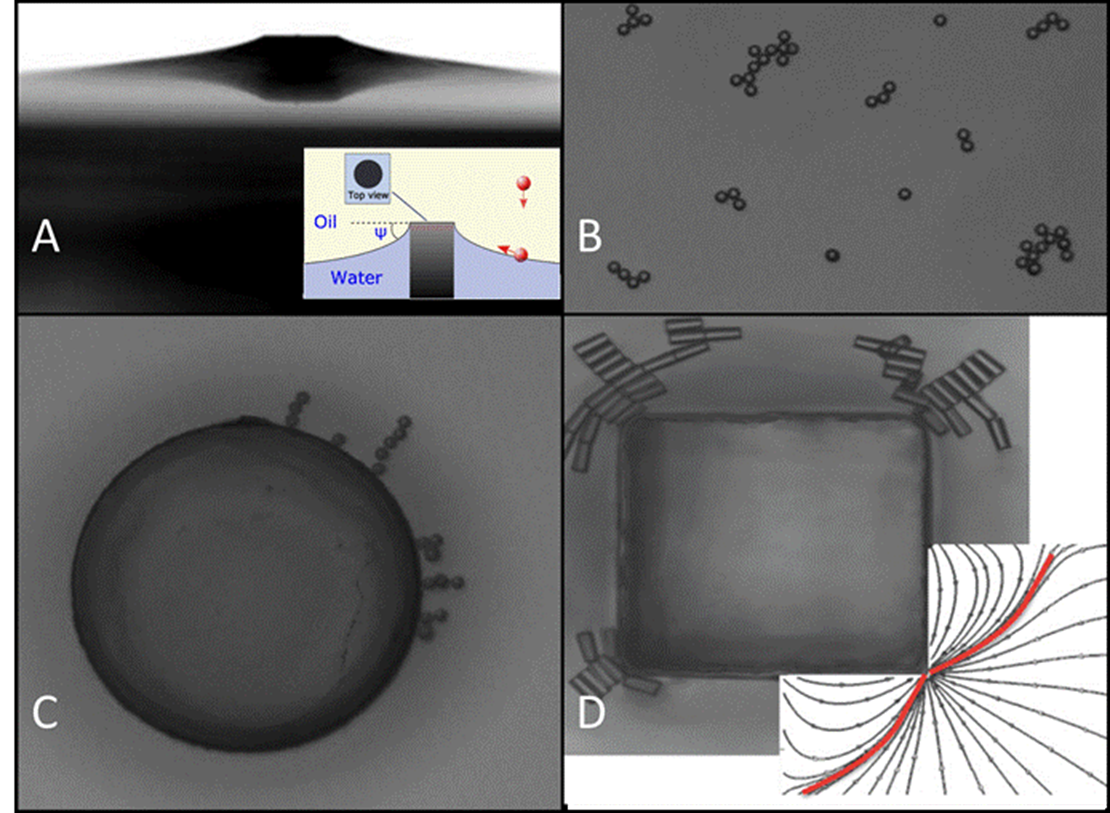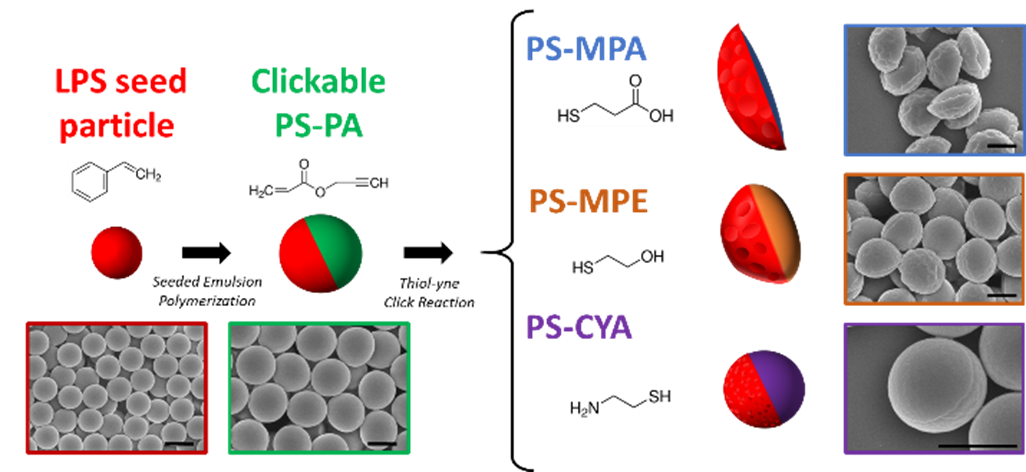Reports: ND1055260-ND10: Analogies between Dense Microparticle Monolayers at Fluid Interfaces and 2D Granular Matter
Kathleen J. Stebe, PhD, University of Pennsylvania
We study structure formation and rearrangement in layers of particles at fluid interfaces. Fluid interfaces allow us to advance fundamental understanding near the jamming limit, as microparticles at fluid interfaces have directional attractive capillary interactions lacking in the dry granular systems on which much of the jamming literature has focused. Particles at fluid interfaces also form structures that depend on their size, shape, wetting and interface curvature. Since interface curvatures are often present, this latter feature must be understood.
We are studying structure formation and rearrangement for two extreme cases, characterized in terms of the trapping energies at the interface, i.e. the pronounced reduction in free energy that occurs when particles locate at fluid interfaces, eliminating a patch of fluid interface dA with associated energy reduction ~ TdA, where T is the interfacial tension. We address particles with strong trapping energies and directional interactions, well in excess of kBT. In the other extreme, we address particles with weak or tunable trapping energies that can spontaneously adsorb and desorb from the interface. Below, I summarize three arenas in which we have made significant progress and then delineate the path forward for this project.
2. Research Progress and Results
2.1 Particles with strong trapping energies and directional interactions
We have improved our understanding of particle structure formation in curvature fields by spherical, disk shaped and cylindrical microparticles at curved fluid interfaces (Figure 1). We mold curvature fields around microposts with typical radius or sides of 150um; the post radius serves as a scale bar in Fig 1A. Far from the micropost, (capillary lengths away), is a confining ring. The volume between the post and the ring is gently filled with water, so that the contact line pins at the post edge with an angle (Psi) of ~15o (inset to Fig 1A). Hexadecane is gently placed over the water layer, forming an oil-water interface. For the circular-shaped micropost, in the region of interest within several post radii to contact with the post, the interface shape is a monopole, i.e. the height decays logarithmically from the edge of the post, and the curvature field is known (Fig. 1A). Particles on this interface form structures with well-defined symmetries owing to capillarity; their arrangement depends on the local deviatoric curvature gradient, i.e. the difference between the two principal curvatures. To minimize excess interface area, microspheres and microdisks form structures with quadrupolar symmetries owing to their dominant capillary mode on interfaces with weak curvature gradients, as shown in Fig 1B for 10 um PS spheres roughly 200-300 um away from the the micropost, where curvature gradients are weak. The particles form linear structures along principal axes on surfaces with strong curvature gradients, as is shown for 10 um PS spheres immediately adjacent to the post, as shown in Fig. 1C. Similar structures for SU-8 disks 10 um in diameter. The structures that form also depend strongly on the presence of corners with associated strong curvature gradients (Fig.1D), as particles move along principal axes driven by deviatoric curvature gradients to accumulate at the post’s edge. Spheres and disks are attracted to the corners of the post. Thereafter, subsequent particles approach the edge in a manner analogous to diffusion limited aggregation in a strong external field. They build up structures influenced by the curvature gradients, the particle shape and the particle wetting. Particle shape also strongly influences the packings that form, as is shown for cylindrical SU-8 microparticles (~7um in diameter) in Fig. 1D.
Figure 1.
2.2 Particles with weak trapping energies
We have developed a versatile, rapid, scalable particle synthesis method for Janus particles suitable for weakly-trapped particle studies. Janus particles are colloidal surfactants with two sides with contrasting functionality. Tailoring the chemistry of each face of the Janus particle enables them to attach to fluid-fluid interfaces. The incorporation of stimuli-responsive moieties can be used to induce changes in the particle morphology, thereby changing their interactions in the layer. Recent research has identified Janus particles that adsorb and desorb like surfactants,i.e. that can overcome the interfacial trapping energies.
Figure 2
The synthesis, summarized in Fig. 2 (Scale bar, 1 micron), uses clickable polystyrene-poly(propargyl acrylate) (PS-PA) Janus particles. Bulk synthesis of the clickable PS-PA Janus particles proceeds from linear polystyrene seed (LPS) particles via seeded emulsion polymerization. The PA monomer contains a click-active acetylene pendant group that participates in thiol-yne click reactions, enabling the particles to be modified with commercially available thiols: 3-mercaptopropionic acid (MPA), 2-mercaptoethanol (MPE), and cysteamine (CYA), to introduce carboxyl, hydroxyl, or amine moieties. The extent of modification can be controlled by reaction time and particle concentration. We can fabricate particles of differing morphologies and composite Janus particles via sequential click reactions. The new, clickable Janus particles adsorb spontaneously at interfaces. They containing pH-responsive carboxylic acid groups allowing strong changes in the chemistry and shape of such Janus particles. We will study dense packings of these layers under controlled perturbations.
2.3 Magnetically driven probe in the interface
In collaboration with roboticist Vijay Kumar at UPenn, we have developed a magnetically actuated probe for the interface. The probe is similar in size and shape the micropost cross sections above, and can be trapped at the fluid interface. Comprised of PDMS impregnated with a ferrite magnetic material cut into different shapes, the probe is driven by magnetic forces and torques generated by magnetic coils situated around the optical microscope. It can be controlled via joystick or via inputs to dictate its position, rotation and speed.
3. Plans for the coming year
Thus far, we have built tools to understand packings and to develop probes. In the coming year, we will study denser layers of both particle types. We will exploit the probe to form interface curvature fields, to form dense layers of both types of microparticles by sequential addition. The probe will be used to perturb the layer. Structural rearrangements (of individual particles, of chains, of the entire layer) will be observed and recorded for surfaces with curvature sources and on nearly planar interfaces.













